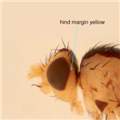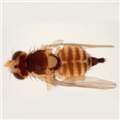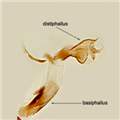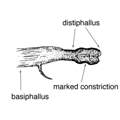
hind margin of eye yellow (A. Ames)

adult, dorsal (A. Ames)

aedeagus (A. Ames)

distiphallus (after Shiao 2004)
Nomenclature
Liriomyza trifolii (Burgess 1880)
Oscinis trifolii Burgess 1880 [in Riley (1880)]Agromyza phaseolunulata Frost 1943Liriomyza alliovora Frick 1955
Common name: American serpentine leafminer, serpentine leafminer, broad bean leafminer, Californian leafminer, celery leafminer, chrysanthemum leaf miner
Hosts
Liriomyza trifolii is highly polyphagous and has been recorded from 25 families (Spencer 1990). The most important crops attacked are beans, celery, chrysanthemum, cucumber, gerbera, gypsophila, lettuce, onion, potato and tomato (Spencer 1989).
Distribution
Africa: Benin, Cote d'Ivoire, Egypt, Ethiopia, Guinea, Kenya, Madagascar, Mauritius, Mayotte, Morocco, Nigeria, Réunion, Senegal, South Africa, Sudan, Tanzania, Tunisia, Zambia, Zimbabwe Asia: China, India, Iran, Israel, Japan, Jordan, Republic of Korea, Lebanon, Oman, Philippines, Saudi Arabia, Taiwan, Vietnam, Yemen Central America: Argentina, Bahamas, Barbados, Bermuda, Brazil, Chile, Colombia, Costa Rica, Cuba, Dominican Republic, Ecuador, French Guiana, Guadeloupe, Guatemala, Guyana, Martinique, Netherlands Antilles, Peru, Puerto Rico, Trinidad and Tobago, Venezuela, British Virgin Islands, U.S. Virgin Islands. Europe: Austria, Belgium, Central Russia, Croatia, Cyprus, France, Greece, Italy, Malta, Netherlands, Norway, Portugal, Romania, Russian Federation, Slovenia, Southern Russia, Spain, Switzerland, Turkey North America: Canada, Mexico, USA Oceania: American Samoa, Australia (Kununurra, WA 2021, Thursday Island 2021), Fiji, Guam, Federated States of Micronesia, Northern Mariana Islands, Samoa, Tonga
Based on data from Crop Protection Compendium (2007),
Key characters
Head with frons and orbits yellow, hind margin of eye largely yellow, at most slightly darkened centrally, third antennal segment yellow, femur yellow with occasional slight brownish striations, mesonotum matt black with grey undertone, both vertical bristles on yellow ground. Wing with last section of CuA1 3-4 times length of penultimate section, wing length 1.2-1.9 mm. Aedeagus: distiphallus with one distal bulb with marked constriction between upper and lower halves. External morphology is very similar to L. katoi and L. yasumatsui. Identification requires examination of male genitalia. Detailed descriptions can be found in Dempewolf (2004), EPPO (2005), Malipatil et al. (2004), Spencer (1965, 1973) and Shiao (2004). The National Diagnostic Protocol for Liromyza trifolii should be consulted (Subcommittee on Plant Health Diagnostics 2016). Key diagnostic features are shown in the PaDIL diagnostic images (Malipatil 2007). The larva of L. trifolii forms a tightly coiled, almost blotch-like mine. Feng et al. (2007) described a rapid molecular test to diagnose L. trifolii.The development of multiplex real-time PCR assays based on the COI gene, which allows rapid detection of all life stages of L. huidobrensis, L. sativae and L. trifolii in a single test is a major advance for routine diagnostic use (Nakamura et al. 2013; Sooda et al. 2017) Molecular Diagnostics
Notes
The biology and ecology of L. trifolii (together with other polyphagous Liriomyza spp.) have been reviewed by Minkenberg & van Lenteren (1986), Murphy & LaSalle (1999), Parrella (1982, 1987), Reitz et al. (2013) and Waterhouse & Norris (1987). Biological control of leafminers in protected crops has been reviewed by Chow & Heinz (2004) and van der Linden (2004).
In the USA, L. trifolii became the dominant agromyzid pest in the USA, displacing L. sativae. This was attributed, at least in part, to its reduced levels of insecticide susceptibility to a wide range of insecticides (Parrella & Keil 1984; Palumbo et al. 1994). However, in Japan, L. trifolii is now being displaced by L. sativae (Abe & Tokumaru 2007), which is attributed to the higher fecundity of L. sativae (Tokumaru & Abe 2003) and to the inability of Dacnusa sibirica, an effective braconid parasitoid of L. trifolii, to complete development on L. sativae (Abe et al. 2005).
In Australia, L. trifolii was detected near Kununurra in the Ord River Irrigation Area in Western Australia in March 2021, and on Thursday Island in the Torres Strait in May 2021. The identity of the specimens was confirmed in July 2021. The Consultative Committee on Emergency Plant Pests, met on 19 July 2021 and agreed that American serpentine leafminer is considered an emergency plant pest under the Emergency Plant Pest Deed, but further information was needed to determine whether it was technically feasible to eradicate. Current Response (19 July 2021)
Reitz & Trumble (2002) suggested that there may be cryptic species within L. trifolii. They found flies in southern Californian fly populations were polyphagous but that central Californian populations were now restricted to capsicum. They also found that L. langei (the North American clade of L. huidobrensis reinstated to species level by Scheffer & Lewis (2001)) was displacing L. trifolii in central California. Scheffer & Lewis (2006) used cytochrome oxidase 1 sequence variation to detect two major clades (A and W) within L. trifolii. They also concluded that the pepper-feeding flies (from California, Florida, Mexico and Honduras) formed a genetically distinct clade (nested within clade W). All Old World samples of L. trifolii were from clade W, with nearly all (92%) being the same haplotype (T.9), suggesting that invasive populations of L. trifolii came from restricted areas in North America. Not surprisingly, specimens from Fiji, Indonesia and Kenya were also found to be the T.9 haplotype (Xu et al. 2021).
In southern Australia, common agromyzids such as L. chenopodii, L. brassicae and Chromatomyia syngenesiae (usually on Sonchus oleraceus) on weeds and other non-crop plants would act as important reservoirs for populations of parasitoids (e.g. Diglyphus isaea (Walker)) of L. trifolii and invasive polyphagous agromyzids (Bjorksten et al. 2005; Lardner 1991, Ridland et al.).
References
Abe Y & Tokumaru S (2008). Displacement in two invasive species of leafminer fly in different localities. Biological Invasions. 10: 951-953.
Abe Y, Takeuchi T, Tokumaru S & Kamata J (2005). Comparison of the suitability of three pest leafminers (Diptera: Agromyzidae) as hosts for the parasitoid Dacnusa sibirica (Hymenoptera: Braconidae). European Journal of Entomology 102: 805-807.
Bjorksten TA, Robinson M & La Salle J (2005). Species composition and population dynamics of leafmining flies and their parasitoids in Victoria. Australian Journal of Entomology 44: 186-191.
Chow A & Heinz KM (2004). Biological control of leafminers on ornamental crops. In Biocontrol in Protected Culture (eds Heinz KM, Van Driesche RG & Parrella MP), Ball Publishing, Batavia, Illinois, pp. 221-238.
Crop Protection Compendium (2007). 2007 Edition © CAB International, Wallingford, UK.
Dempewolf M (2004). Arthropods of Economic Importance - Agromyzidae of the World (CD-ROM). ETI. University of Amsterdam, Amsterdam. https://agromyzidae.linnaeus.naturalis.nl/linnaeus_ng/app/views/species/nsr_taxon.php?id=57057&epi=55
EPPO (2005). Liriomyza spp. EPPO Bulletin 35: 335-344.
Feng X, Chen N-Z, Ma J, Zhu S-F & Hu X-N (2007). Molecular identification of Liriomyza trifolii (Burgess) (Dipt., Agromyzidae) based on real-time PCR. Journal of Applied Entomology 131: 548-552.
Frick KE (1955). Nearctic species in the Liriomyza pusilla complex, No. 3. L. alliovora, new name for the Iowa onion miner. Journal of the Kansas Entomological Society 28: 88-92.
Frost SW (1943). Three new species of Diptera related to Agromyza pusilla Meig. Journal of the New York Entomological Society 51: 253-263.
Lardner RM (1991). Comparative host stage utilization of two parasitoids of Liriomyza brassicae (Diptera: Agromyzidae). PhD Thesis, University of Adelaide. thesis details
Malipatil MB (2007). American serpentine leafminer (Liriomyza trifolii) Pest and Diseases Image Library. Updated on 11/07/2007 10:58:12 AM. Available online: http://www.padil.gov.au
Malipatil MB, Ridland PM, Rauf A, Watung, J & Kandowangko D (2004). New records of Liriomyza Mik (Agromyzidae: Diptera) leafminers from Indonesia. Formosan Entomologist 24: 287-292. pdf
Minkenberg OPJM & van Lenteren JC (1986). The leafminers Liriomyza bryoniae and L. trifolii (Diptera: Agromyzidae), their parasites and host plants: a review. Agricultural University Wageningen Papers 86-2: 50 pp. Wageningen.
Murphy ST & La Salle J (1999). Balancing biological control strategies in the IPM of New World invasive Liriomyza leafminers in field vegetable crops. Biocontrol News and Information 20: 91N-104N.
Nakamura S, Masuda T, Mochizuk A, Konishi K, Tokumaru S, Ueno K & Yamaguchi T (2013). Primer design for identifying economically important Liriomyza species (Diptera: Agromyzidae) by multiplex PCR. Molecular Ecology Resources 13: 96-102.
Parrella MP (1982). A review of the history and taxonomy of economically important serpentine leafminers (Liriomyza spp.) in California (Diptera: Agromyzidae). Pan-Pacific Entomologist 58: 302-308.
Parrella MP (1987). Biology of Liriomyza. Annual Review of Entomology 32: 201-224.
Parrella MP & Keil CB (1984). Insect pest management: The lesson of Liriomyza. Bulletin of the Entomological Society of America 30: 22-25.
Palumbo JC, Mullis CH, Jr & Reyes FJ (1994). Composition, seasonal abundance, and parasitism of Liriomyza (Diptera: Agromyzidae) species on lettuce in Arizona. Journal of Economic Entomology 87: 1070-1077.
Reitz SR & Trumble JT (2002). Interspecific and intraspecific differences in two Liriomyza leafminer species in California. Entomologia Experimentalis et Applicata 102: 101-113.
Reitz SR, Gao Y & Lei Z (2013). Insecticide use and the ecology of invasive Liriomyza leafminer management Inem> Insecticides – Development of Safer and More Effective Technologies (ed. S Trdan). InTech, Rijeka, Croatia. https://www.intechopen.com/books/insecticides-development-of-safer-and-more-effective-technologies/insecticide-use-and-the-ecology-of-invasive-liriomyza-leafminer-management
Ridland PM, Umina PA, Pirtle EI & Hoffmann AA (2020). Potential for biological control of the vegetable leafminer, Liriomyza sativae (Diptera: Agromyzidae), in Australia with parasitoid wasps. Austral Entomology 59: 16-36. https://doi.org/10.1111/aen.12444
Riley CV (1880). The clover Oscinis (Oscinis trifolii, Burgess [n.sp.]). United States Department of Agriculture Report 1879: 200-201.pdf
Scheffer SJ & Lewis ML (2001). Two nuclear genes confirm mitochondrial evidence of cryptic species within Liriomyza huidobrensis (Diptera: Agromyzidae). Annals of the Entomological Society of America 94: 648-653.
Scheffer SJ & Lewis ML (2006). Mitochondrial phylogeography of the vegetable pest Liriomyza trifolii (Diptera: Agromyzidae): diverged clades and invasive populations. Annals of the Entomological Society of America 99: 991-998.
Shiao SF (2004). Morphological diagnosis of six Liriomyza species (Diptera: Agromyzidae) of quarantine importance in Taiwan. Applied Entomology and Zoology 39: 27–39. abstract, pdf
Sooda A, Gunawardana D, Li D & Kumarasinghe K (2017). Multiplex real-time PCR assay for the detection of three invasive leafminer species: Liriomyza huidobrensis, L. sativae and L. trifolii (Diptera: Agromyzidae). Austral Entomology 56, 153-159.
Spencer KA (1965) A clarification of the status of Liriomyza trifolii (Burgess) and some related species (Diptera: Agromyzidae). Proceedings of the Entomological Society of Washington 67: 32-40.
Spencer KA (1973). Agromyzidae (Diptera) of economic importance. Series Entomologica 9. Dr W Junk, The Hague. 418 pp.
Spencer KA (1989) Leaf miners. Plant Protection and Quarantine, Vol. 2, Selected Pests and Pathogens of Quarantine Significance (ed. Kahn RP). CRC Press, Boca Raton, pp. 77-98.
Spencer KA (1990). Host specialization in the world Agromyzidae (Diptera). Series Entomologica 45. Kluwer Academic Publishers, Dordrecht. 444 pp.
Subcommittee on Plant Health Diagnostics (2016). National Diagnostic Protocol for Liriomyza trifolii — NDP27 V1. (Eds. Subcommittee on Plant Health Diagnostics) Authors Malipatil M, Blacket M, Wainer J, Ridland P; Reviewer Jones DC. ISBN 978-0-9945112-6-3 CC BY 3.0. pdf
Tokumaru S & Abe Y (2003) Effects of temperature and photoperiod on development and reproductive potential of Liriomyza sativae, L. trifolii, and L. bryoniae (Diptera: Agromyzidae) (in Japanese with English summary). Japanese Journal of Applied Entomology and Zoology 47: 143-152.
van der Linden A (2004). Biological control of leafminers on vegetable crops. In Biocontrol in Protected Culture (eds Heinz KM, Van Driesche RG & Parrella MP), Ball Publishing, Batavia, Illinois, pp. 239-251.
Waterhouse DF & Norris KR (1987). Biological control. Pacific prospects. ACIAR. Inkata Press Melbourne.
Xu X, Coquilleau MP, Ridland PM, Umina PA, Yang Q & Hoffmann AA, Molecular identification of leafmining flies from Australia including new Liriomyza outbreaks. Journal of Economic Entomology, toab143, https://doi.org/10.1093/jee/toab143
WWW Resources
EPPO information on Liriomyza trifolii https://gd.eppo.int/taxon/LIRITR/documents" target=_blank>fact sheet, diagnostic protocol, images
PaDIL diagnostic images and fact sheet. American serpentine leafminer, Liriomyza trifolii (Burgess) (Diptera: Agromyzidae) Pest and Diseases Image Library. Updated on 11.vii.2007. http://www.padil.gov.au/pests-and-diseases/Pest/Main/136236
Liriomyza trifolii in Dempewolf M (2004). Arthropods of Economic Importance - Agromyzidae of the World
Liriomyza trifolii in Ellis WN (2018). Plant Parasites of Europe - leafminers, galls and fungi
Liriomyza trifolii in Pitkin B, Ellis W, Plant C & Edmunds (2008). The leaf and stem mines of British flies and other insects
Liriomyza trifolii in Martinez M (2007). Fauna Europaea: Agromyzidae. In Pape T (ed.) (2007) Fauna Europaea: Diptera: Brachycera. Version 1.3 [128237]
Updated
2021-07-28




















